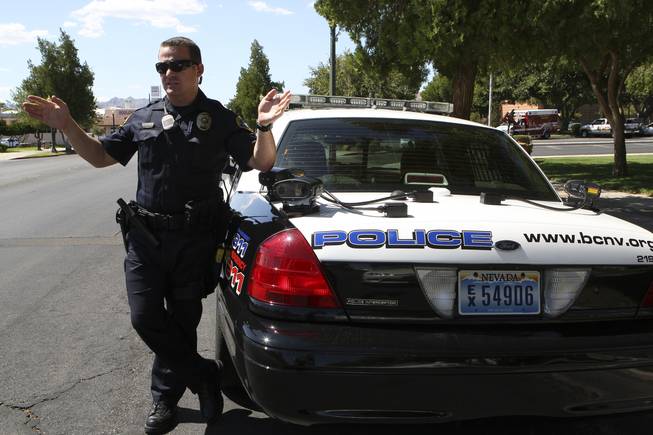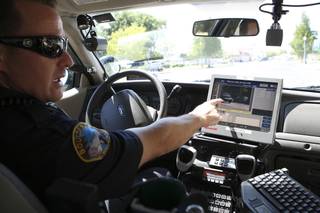
Mona Shield Payne / Special to the Sun
Officer Thomas Healing discusses the width perimeter capabilities of the license plate readers affixed to his Boulder City Police patrol vehicle.
Monday, Sept. 14, 2009 | 2:05 a.m.
Mobile Plate Hunter - Salem, Mass.
Sun Coverage
Beyond the Sun
In their first weeks on the road, the Boulder City Police Department’s license plate readers haven’t put anyone behind bars. They haven’t spotted any stolen cars or suspected drug runners cruising through town.
But Officer Thomas Healing, who drives one of the two patrol cars equipped with the new technology, has discovered that one of the vehicles in the Police Department’s fleet has a license number that matches a stolen vehicle in another state. His machine provides him a noisy alert every time he passes it in the police station’s parking lot.
The Boulder City Police Department spent $50,000 of drug interdiction and grant money to buy the system that Police Chief Thomas Finn calls a “force multiplier.”
The system checks 60 license plates per minute, Healing said, as opposed to 50 to 60 plates per shift that a typical officer can do.
The technology was created about 30 years ago in Italy to automate its post offices, said Mark Windover, chief executive officer of ELSAG North America, which makes the system Boulder City uses. It was adapted for law enforcement 10 years ago and now is used by more than 600 police agencies in 50 states, he said.
The system in Boulder City consists of three cameras mounted on the trunk of a police car — two on the driver’s side pointed at angles in opposite directions and one on the passenger’s side pointed forward at an angle. The cameras on the driver’s side have 50mm lenses to capture images across several lanes of traffic, Healing said. The one on the passenger’s side has a 25mm lens to get a look at cars one lane over or parked at the curb.
The computer already installed inside the police car has software that shows photos of the license plates as they are taken, beeping softly with each one. When it finds something that doesn’t match, it lets out a hoarse, staccato alert followed by a computerized voice saying whether the license plate is potentially stolen, has a warrant attached or some other problem.
The software continues to beep loudly and steadily until the officer checks it against the photo and either accepts or rejects the information.
The extra camera on the driver’s side helps officers identify vehicles from states that do not require front license plates, Healing said. As the vehicle passes the police car, the rear camera captures a picture of the back plate.
The cameras seek out reflective material that has text to identify as license plates. Often it will record a sign. During a recent demonstration, it recorded the sign for City Hall and the Police Department and alerted Healing that a sign for Hoover Dam was a stolen plate.
“Look, it took a picture of a fence there,” Healing said. “It read it as 11111111. You just have to get used to that.”
Because of the sensitivity and the potential to incorrectly identify a license plate, Healing said, no stops are made just on the basis of an alert. Officers run a suspicious plate through the data base manually to double check the automated reader before pulling someone over, he said. The extra step takes only a few seconds.
The hope is to identify suspicious activity that otherwise could fall through the cracks, Healing said. The automated reader saves the photos of license plates and associated GPS coordinates for 30 days, so if a crime is recorded in a neighborhood, he can go back and check to see whether he might have gathered information that would shed some light on it.
The ultimate goal, he said, is to get information from the Drug Enforcement Administration on vehicles being used for drug trafficking on U.S. 93 and 95, two of the north-south routes between Mexico and the United States that go through Boulder City.
Healing said he feels lucky that he was one of the two officers to get the system on his car.
“We are going to make the best of it,” he said.
Jean Reid Norman can be reached at 948-2073 or [email protected].


Join the Discussion:
Check this out for a full explanation of our conversion to the LiveFyre commenting system and instructions on how to sign up for an account.
Full comments policy